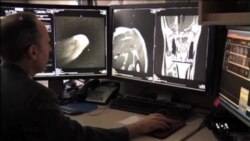Medical researchers in 2014 reported interesting advances and even breakthroughs in the use of technology to help patients suffering from different diseases and injuries.
Magnetic resonance imaging machines, for instance, have been a valuable tool for doctors since the 1980s, but they've been able to show only static pictures. This year, researchers at the University of California-Davis reported that they have developed a way to use MRI scanners to capture moving images of body parts.
Orthopedic surgeon Robert Szabo is already using an Active MRI scanner.
“We can understand why one person develops an unstable wrist, why one person has pain and wears out the joint surface in one area of the wrist, and what we can do to replace, make better products or even make soft tissue corrections to improve that patient’s life,” he said.
Severe spinal cord injuries usually lead to total loss of control of lower extremities, as well as bladder, bowel and sexual functions. Scientists at the University of Louisville in Kentucky used implanted electrical devices to help patients regain at least some of those functions.
Dr. Roderic Pettigrew of the National Institutes of Health said a spinal cord injury may no longer mean lifelong paralysis.
Noting the progress of patients who had regained voluntary control of limbs and other bodily functions, he called the developments with electrical implantations "very exciting. It is a milestone."
Researchers at Chalmers University of Technology in Gothenburg, Sweden, continued to develop brain implants for prosthetic devices that behave and feel sensation just like real arms and hands. And Medtronic Corp. in the U.S. used electrical brain stimulation to relieve symptoms of Parkinson's disease.
Parkinson's patient David Dewsnap said that before receiving such treatment, he couldn’t take even a short walk.
“It has given me my life back," he said. "This procedure has been just amazing for me. Without seeing me before, you don't really understand what it was like. The left side of my body, I could not use it, really.”
Also this year, scientists came closer to fulfilling the promise that stem cells may someday help regenerate damaged tissue.
Scientists at the University of Pittsburgh School of Medicine reported that some of their severely injured patients grew new muscle tissue with the help of stem cells growing on a matrix made of pig’s bladder.
Three-dimensional printers proved this year to be useful in medicine as well. Chinese doctors printed a replacement vertebra for a severely injured teenager.
Beijing University orthopedics head Dr. Liu Zhongjun, who led the surgical team, said 3-D printing is a huge advantage for artificial implants.
“We can use iconographic tests on patients such as a CT scan, converting CT data to 3-D printing data in order to produce an internal fixation, with exactly the same structure as the patient's bone structure," he said.
With all the promising developments in medical technology this year, 2015 may bring even more breakthroughs in this important field.











